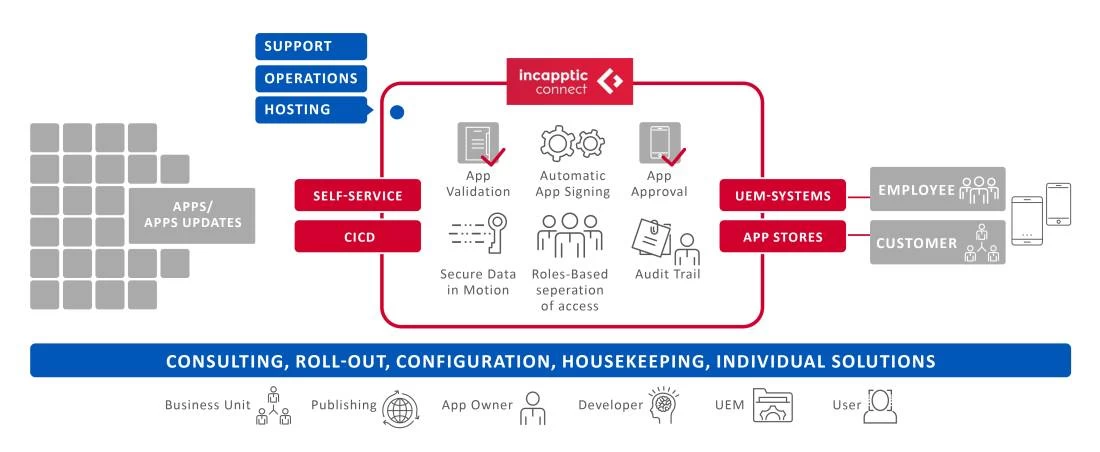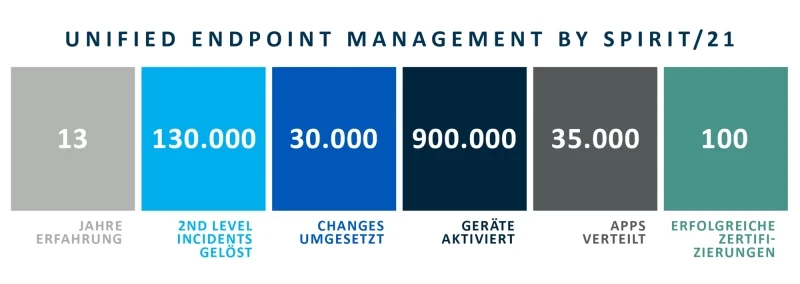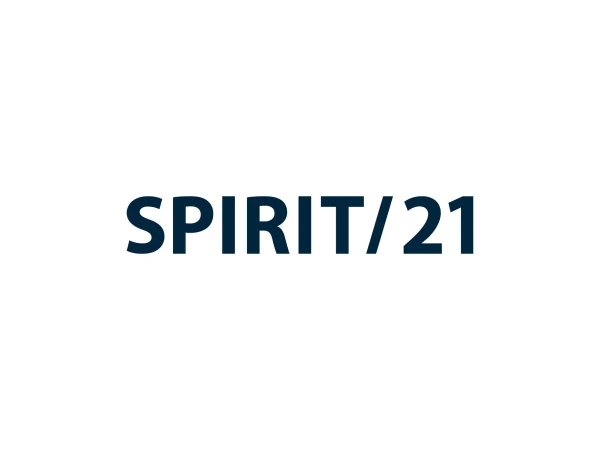This is the second article in a multi-part series on the topic Application Lifecycle Management. In first part, we looked at the processes, challenges and stakeholders involved. In part 2, we describe how special software can be used to efficiently design processes, optimally integrate stakeholders and reduce lead times from several days to just a few minutes.
Deploying an app or an app update can develop into a complex, non-transparent and very time-consuming procedure, especially in large organizations (see Part 1). This is mainly due to the predominantly manual processes and indirect feedback to those involved within a process step.
Suitable software solutions accelerate the processes
In the following, we outline the process with the support of incapptic Connect, a software from MobileIron that makes managing app release processes much easier.
The starting point of the process remains the department that requires a specific application. The product manager can now integrate the developers in incapptic Connect, who upload the app to the system independently and easily. The first automated plausibility tests, such as version or build number, size and availability of icons, correct file structure, etc., are carried out. Direct feedback allows the developers to make any necessary adjustments independently and ensures that only formally correct content makes it into the subsequent process. Without these checks, errors would only become apparent much later in the process and would have to be corrected at great expense.
Automation reduces sources of error and simplifies the rollout
In the next step, the app is automatically packaged and signed. Any necessary push certificates or provisioning profiles are automatically generated and integrated by the system at Apple or Google. The original tasks of the publishing team are thus fully automated and integrated into the process without media disruptions.

The app is then rolled out company-wide to the various users. Using configurable workflows, the app can be distributed directly from incapptic Connect to the desired target group via a corresponding UEM system. The required app files and necessary configurations are automatically provisioned in the respective UEM system. The system supports MobileIron itself as well as Microsoft Intune and VMware Workspace ONE UEM.
Of course, this process can be extended to include various quality levels. For example, we recommend only authorizing the product owner to a limited group of users or test users. Before a productive application is distributed to users, the app should be checked by a central role using a standardized test and only published by this role. Due to the close connection between UEM and app release management, the UEM team is suitable for this role. In addition to the technical expertise required for the distribution of apps, this team can also assess the impact on the operation of the UEM system.
The above illustration shows how an integrated platform can make the necessary processes more transparent and largely automate them. incapptic Connect can also provide valuable services in the further course of the app life cycle. For example, the system provides statistics on app usage for the respective product managers. From an operational and support perspective, the feature for warning of expiring provisioning profiles is interesting, ensuring that applications are renewed in good time. If this is not done, the apps can no longer be used.
We have summarized the advantages and functions of the system below. We have also listed other important aspects of app release processes that we have not covered so far. We present the topics of security & compliance in Part 3 App Publishing: Security & Compliance always in view.
Advantages of incapptic Connect in the app release process
- Fast provision of updates, bug fixes, security fixes
- Avoidance of human errors
- Cost savings through simplification & automation of processes
- Insight into the use of applications
- Compliance with internal guidelines and app store requirements
- Transparency through log files & audit trails
- Increased security through role-based access and secure data transfer
- Functions of incapptic Connect in the app release process
Self-service functions for developers and product managers
- Approval workflows
- Automatic signing of the app code
- Automatic generation of push notification certificates
- Verification of metadata
- Integration of CICD toolchains (e.g. Jenkins)
- Direct provisioning of apps in the EMM systems
- Monitoring the validity of certificates & profiles

Learn more

Application Lifecycle Management by SPIRIT/21 - Part 1: What processes are involved and which stakeholders are involved.

Application Lifecycle Management by SPIRIT/21 - Part 2: How processes can be designed efficiently and throughput times can be shortened.

App Lifecycle Management by SPIRIT/21 - Part 4: What is important for onboarding, deployment and deprovisioning.
Team SPIRIT/21
E-Mail: info@spirit21.com
The SPIRIT/21 team will be happy to advise you on all aspects of your IT tasks, from consulting and implementation to the operation of individual services and complete IT infrastructures. We deliver solutions that work. We look forward to hearing from you.

